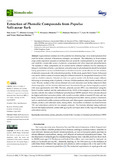Mostrar el registro sencillo del ítem
Extraction of phenolic compounds from populus salicaceae bark
| dc.creator | Autor, E. | es_ES |
| dc.creator | Cornejo Ibergallartu, Alfonso | es_ES |
| dc.creator | Bimbela Serrano, Fernando | es_ES |
| dc.creator | Maisterra Udi, Maitane | es_ES |
| dc.creator | Gandía Pascual, Luis | es_ES |
| dc.creator | Martínez-Merino, V. | es_ES |
| dc.date.accessioned | 2022-06-30T11:54:21Z | |
| dc.date.available | 2022-06-30T11:54:21Z | |
| dc.date.issued | 2022 | |
| dc.identifier.citation | Autor, E.; Cornejo-Ibergallartu, A.; Bimbela-Serrano, F.; Maisterra-Udi, M.; Gandía-PascualE, L. M.; Martínez-Merino, V.. (2022). Extraction of phenolic compounds from populus salicaceae bark. Biomolecules. 12,4 . | es |
| dc.identifier.issn | 2218-273X | |
| dc.identifier.uri | https://hdl.handle.net/2454/43276 | |
| dc.description.abstract | Lignocellulosic residues have the potential for obtaining high value-added products that could be better valorized if biorefinery strategies are adopted. The debarking of short-rotation crops yields important amounts of residues that are currently underexploited as low-grade fuel and could be a renewable source of phenolic compounds and other important phytochemicals. The isolation of these compounds can be carried out by different methods, but for attaining an integral valorization of barks, a preliminary extraction step for phytochemicals should be included. Using optimized extraction methods based on Soxhlet extraction can be effective for the isolation of phenolic compounds with antioxidant properties. In this study, poplar bark (Populus Salicaceae) was used to obtain a series of extracts using five different solvents in a sequential extraction of 24 h each in a Soxhlet extractor. Selected solvents were put in contact with the bark sample raffinate following an increasing order of polarity: n-hexane, dichloromethane, ethyl acetate, methanol, and water. The oily residues of the extracts obtained after each extraction were further subjected to flash chromatography, and the fractions obtained were characterized by gas chromatography coupled with mass spectrometry (GC–MS). The total phenolic content (TPC) was determined using the Folin–Ciocalteu method, and the antioxidant activity (AOA) of the samples was evaluated in their reaction with the free radical 2,2-Diphenyl-picrylhydrazyl (DPPH method). Polar solvents allowed for higher individual extraction yields, with overall extraction yields at around 23% (dry, ash-free basis). Different compounds were identified, including hydrolyzable tannins, phenolic monomers such as catechol and vanillin, pentoses and hexoses, and other organic compounds such as long-chain alkanes, alcohols, and carboxylic acids, among others. An excellent correlation was found between TPC and antioxidant activity for the samples analyzed. The fractions obtained using methanol showed the highest phenolic content (608 g of gallic acid equivalent (GAE)/mg) and the greatest antioxidant activity. | en |
| dc.description.sponsorship | This research was funded by the Gobierno de Navarra, grant number PC177-178 Reducenano 2.0 and Spanish Ministry of Science (AbFine, PID2020-114936RB-I00). The APC was funded by the Universidad Pública de Navarra (UPNA). | en |
| dc.format.mimetype | application/pdf | en |
| dc.format.mimetype | application/zip | en |
| dc.language.iso | eng | en |
| dc.publisher | MDPI | en |
| dc.relation.ispartof | Biomolecules, 2022, 12 (4), p. 539 | en |
| dc.rights | © 2022 by the authors. This article is an open access article distributed under the terms and conditions of the Creative Commons Attribution (CC BY) license | en |
| dc.rights.uri | http://creativecommons.org/licenses/by/4.0/ | |
| dc.subject | Antioxidants | en |
| dc.subject | Tannins | en |
| dc.subject | Phenolics | en |
| dc.subject | Soxhlet | en |
| dc.subject | Folin-Ciocalteu | en |
| dc.subject | 2,2-Diphenyl-picrylhydrazyl | en |
| dc.subject | DPPH | en |
| dc.title | Extraction of phenolic compounds from populus salicaceae bark | en |
| dc.type | Artículo / Artikulua | es |
| dc.type | info:eu-repo/semantics/article | en |
| dc.date.updated | 2022-06-30T11:50:43Z | |
| dc.contributor.department | Zientziak | eu |
| dc.contributor.department | Institute for Advanced Materials and Mathematics - INAMAT2 | en |
| dc.contributor.department | Ciencias | es_ES |
| dc.rights.accessRights | Acceso abierto / Sarbide irekia | es |
| dc.rights.accessRights | info:eu-repo/semantics/openAccess | en |
| dc.identifier.doi | 10.3390/biom12040539 | |
| dc.relation.projectID | info:eu-repo/grantAgreement/AEI/Plan Estatal de Investigación Científica y Técnica y de Innovación 2017-2020/PID2020-114936RB-I00/ES/ | en |
| dc.relation.publisherversion | https://doi.org/10.3390/biom12040539 | |
| dc.type.version | Versión publicada / Argitaratu den bertsioa | es |
| dc.type.version | info:eu-repo/semantics/publishedVersion | en |
| dc.contributor.funder | Gobierno de Navarra / Nafarroako Gobernua | es |
| dc.contributor.funder | Universidad Pública de Navarra / Nafarroako Unibertsitate | es |



